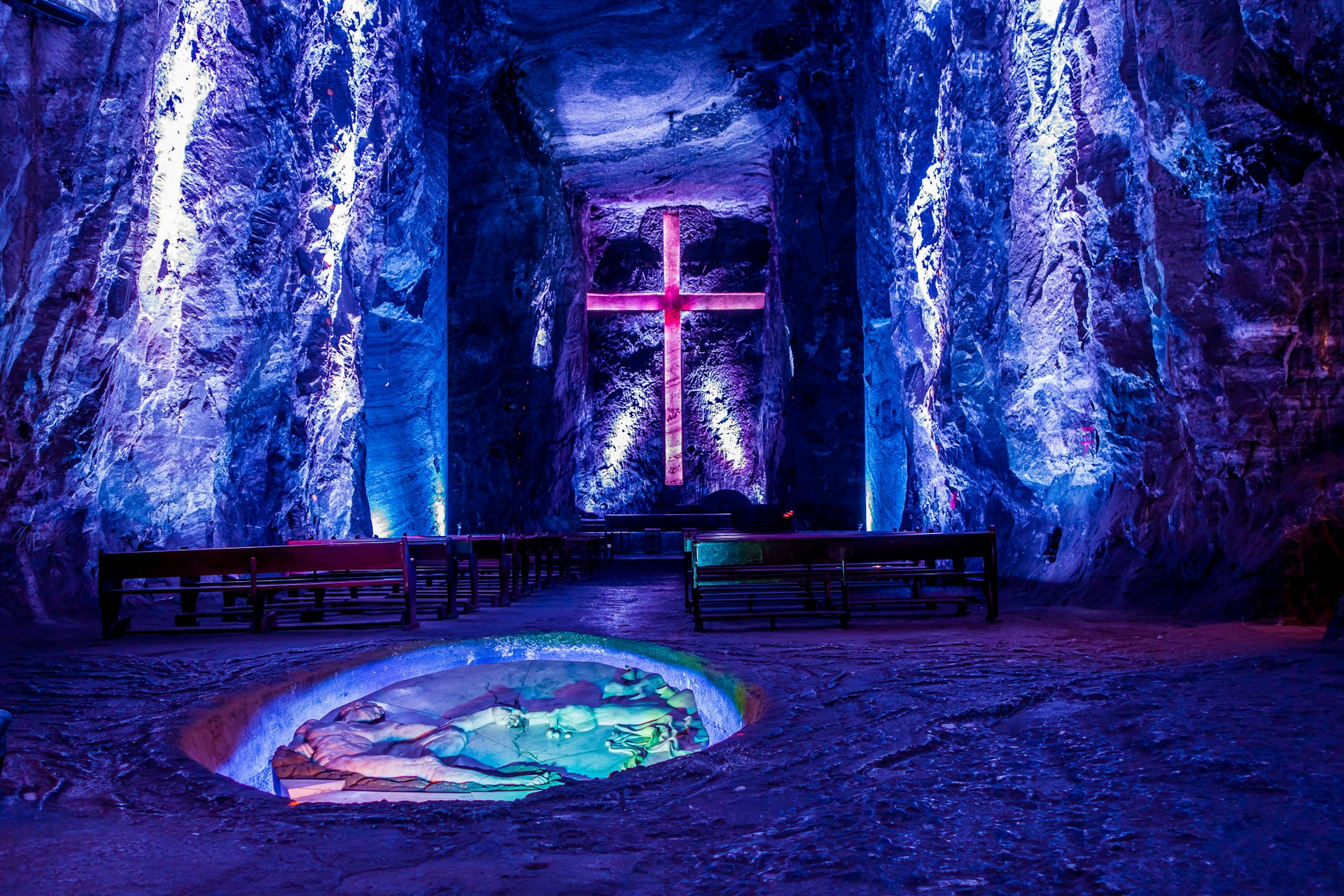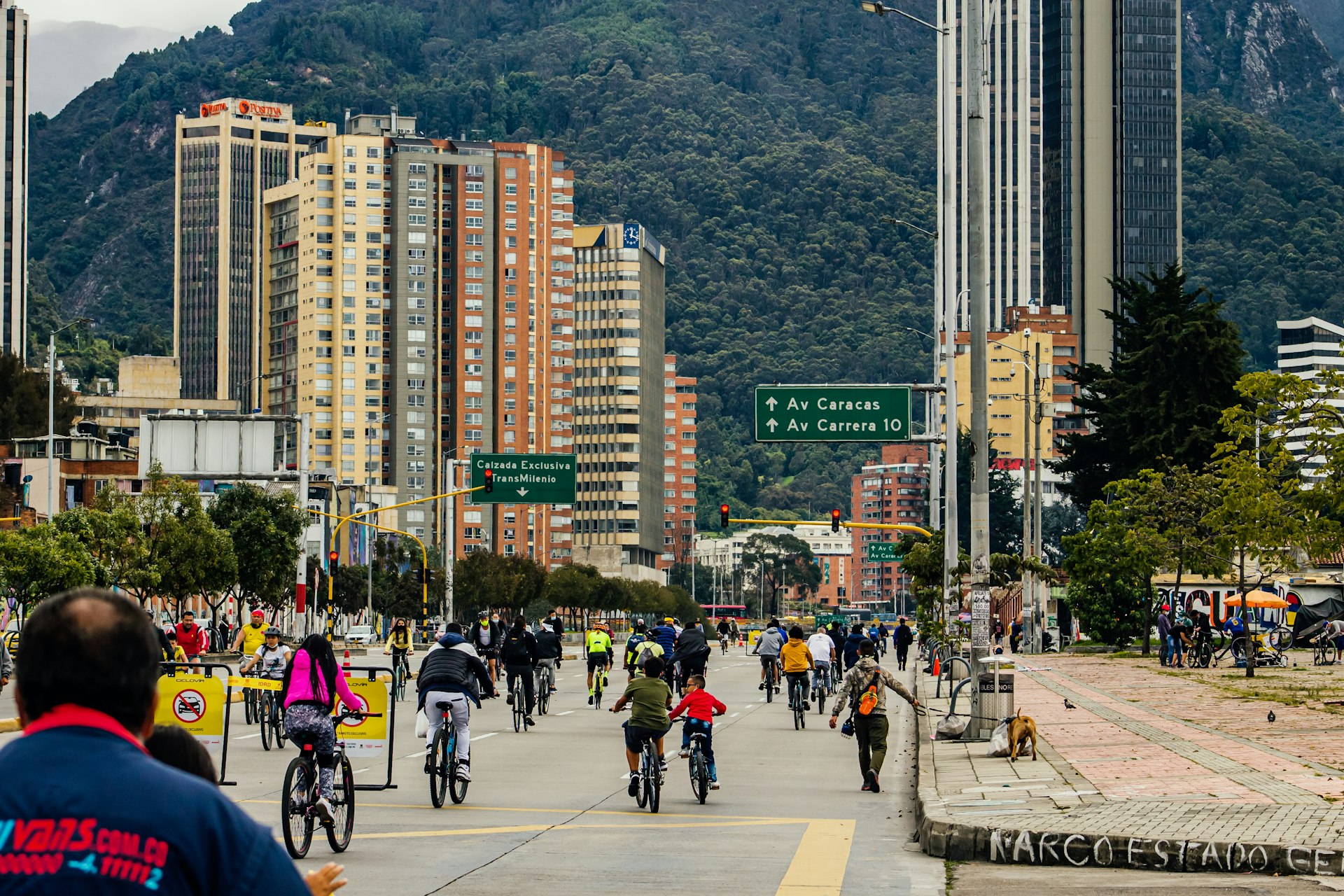
The traffic may be anarchic and there’s no citywide subway system, but Bogotá is still a relatively easy place to navigate.
Two 21st-century innovations have helped ease the gridlock: a comprehensive web of designated bike lanes (over 500km/310 miles of them), and a slick integrated bus system known as the TransMilenio. Taxis plug the gaps when time is of the essence, while most of the headline sights in the historic quarter of Candelaria can be navigated on foot.
For something a little different, you can take a cable car or cable railway to the top of Cerro de Monserrate, the city’s sentinel mountain.
Scout new ways to explore the planet’s wildest places with our weekly newsletter delivered to your inbox.
Join the locals on the TransMilenio
Bogotá’s BRT (Bus Rapid Transit) system is a copy of a pioneering network first piloted in Curitiba, Brazil in the 1970s. Called the TransMilenio, it uses large articulated buses operating in specially dedicated lanes in a system that mimics an above-ground metro. For ease of entry and exit, the buses utilize special purpose-built stations with raised platforms to increase the speed of boarding. When full, the largest buses can carry up to 270 passengers. As of 2023, almost half of the city’s fleet of 3300 buses was electric.
Launched in 2000, the TransMilenio has grown to incorporate 12 lines and 152 stations spread over 114km (70 miles). A fleet of smaller “feeder” buses that share the roads with cars connect to areas where the TransMilenio doesn’t reach.
To use the TransMilenio, you first need to purchase a smartcard called Tullave for COP$7000. The contactless card can be loaded and recharged at any bus station. Fares are relatively cheap costing COP$2950 per ride. Beware: services can get notoriously crowded, especially during rush hour.
 All aboard the heritage train to the incredible salt cathedral © Fotos593 / Shutterstock
All aboard the heritage train to the incredible salt cathedral © Fotos593 / Shutterstock
Take a special heritage train to the Catedral de Sal
A private company known as Tren Turístico de la Sabana runs a weekend-only heritage train from Bogotá’s neoclassical Sabana station to the town of Zipaquira, 42km (26 miles) north of the capital, site of the famous subterranean salt cathedral. It stops at Usaquén en route.
Sabana station is located in the Los Mártires neighborhood, a 20-minute walk from Candelaria’s Plaza de Bolívar.
Three ways to climb a mountain
The Cerro Monserrate rises steeply above the roofs and skyscrapers of downtown Bogotá and is crowned by a handsome basilica and pilgrimage site. Scaling it has become a city rite of passage.
There are several ways to ascend. The most energetic is to puff-and-pant your way to the summit on a paved path with sporadic steps that climb 500 vertical meters over 2.5km (1.5 miles). Bear in mind, Bogotá’s already at a significant altitude, meaning the air is gasp-inducingly thin. Acclimatize before you even think about attempting the climb.
If you’d like to conserve your energy, there’s the option of taking a funicular (cable railway) or a teleférico (cable car). Rather than running simultaneously, the funicular carries morning passengers (until noon), while the teleférico handles the afternoon shift. They both leave from the same spot, a short uphill walk from the Parque de los Periodistas.
The footpath up the mountain closes at 1pm. Most locals start hiking early (it opens at 5am).
Fill in the gaps with a taxi
Bogotá’s fleet of Korean-made yellow taxis is a generally safe, reliable, and inexpensive way of getting around.
It isn’t recommended to wave down a taxi in the street unless you are with a local – and certainly not after dark. When you do so, you’re not registered and therefore forfeit all the security measures put in place to protect you. The best idea is to ask someone at your accommodation or restaurant to book one for you – or to do so yourself. Catching a taxi from the airport arrivals area is generally safe.
Uber and other taxi apps currently work in Bogota, although there have been temporary suspensions of service due to past protests and lawsuits. Check before you set out.
 Rent a bike and takes to the streets to experience Cicolvia © Gabriel Leonardo Guerrero / Shutterstock
Rent a bike and takes to the streets to experience Cicolvia © Gabriel Leonardo Guerrero / Shutterstock
Rent two wheels in one of South America’s great cycling cities
Famous for its revolutionary Ciclovia, when the city closes 127km (79 miles) of its roads to motorized vehicles every Sunday, Bogotá is one of the world’s great cycling metropolises. There are 550km (342 miles) of interlinked ciclorutas (cycling lanes), many of them separated from traffic, allowing cyclists to get around with minimum disruption.
Visitors can rent bikes at Bogotá Bike Tours in Candelaria. The company also offers daily guided rides, a great way to absorb the sights, get oriented and become quickly acquainted with Bogotá’s busy streets and bike etiquette.
You haven’t really experienced Bogotá until you’ve participated in Sunday’s Ciclovia (7am-2pm) when the city flips from a stressed-out traffic hub to a carefree street festival (and back again) for seven blissful hours.
Driving a car? Think again
Renting a car solely to get around Bogotá isn’t a good idea. If you’re from outside South America, you’ll quickly discover that driving is a different sport in this neck of the woods. According to the 2022 INRIX Global Traffic Scorecard, the city is the eighth most congested in the world. The average citizen spends 94 hours a year stuck in stationary or slow-moving traffic – save yourself the stress and don’t do it.
Accessible transportation in Bogotá
The TransMilenio system has relatively good wheelchair accessibility albeit with a few caveats. Most stations have ramps and all buses have at least one designated wheelchair space. Platform entry is similar to that of subway trains, but beware, some stations have a small gap between the bus and the platform.
Monserrate’s funicular and cable car are both wheelchair accessible and the trails on the mountaintop are equipped with step-bypassing ramps, although some of them are quite steep.
Visit Lonely Planet’s Shop for more information on accessible travel.



